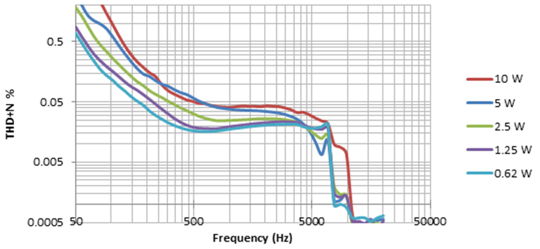SLAA898 September 2022 TAS3251 , TPA3255
4.2.1 Improve Resistance Matching
One cause of the low system efficiency is the low equivalent resistance seen by the amplifier. The equivalent load can be increased by reconfiguring the 18737. From Table 3-1, RL can be about 8 Ω if using tap 1, 3 as primary and tap A, B as secondary (or tap 4 as primary and tap C as secondary). With an 8-Ω load, ηamp increases from 0.8 to about 0.85. The theoretical system efficiency is:
Equation 26.
The final test result is about 0.61, which matches with the estimation. Figure 4-3 shows the THD+N test result with new configuration.
 Figure 4-3 THD+N vs Frequency Results Based on TPA3255 With One
Peavey® Step-up Transformer and 10 Step-Down Transformers (1, 3 as Primary Side and A, B as Secondary Side)
Figure 4-3 THD+N vs Frequency Results Based on TPA3255 With One
Peavey® Step-up Transformer and 10 Step-Down Transformers (1, 3 as Primary Side and A, B as Secondary Side)